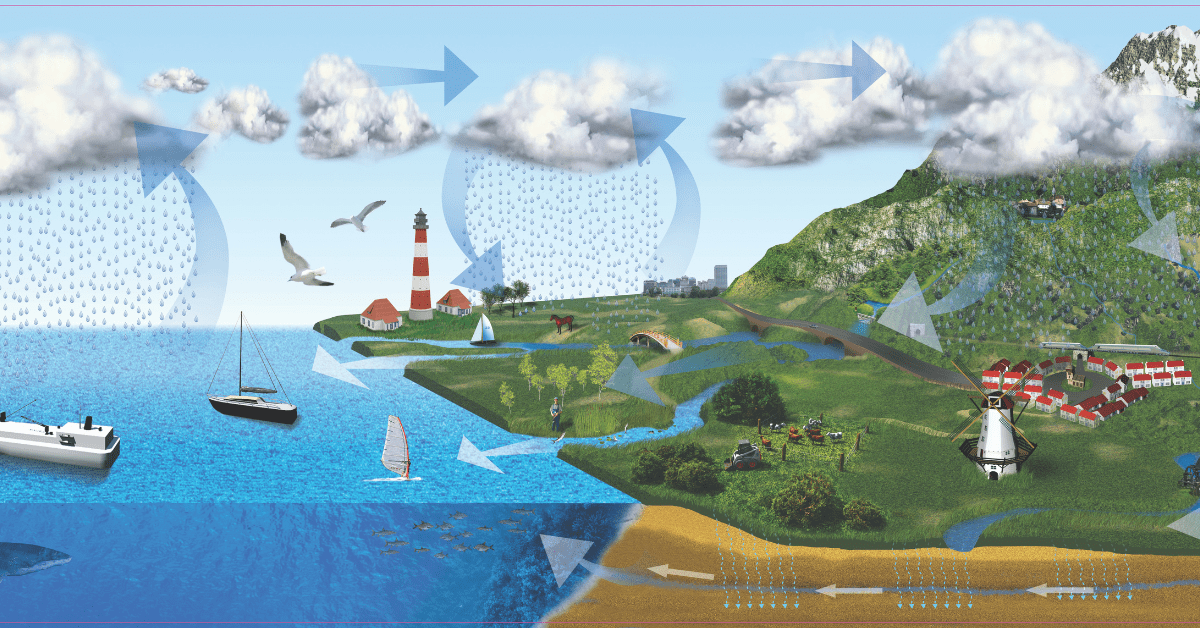Introduction
The water cycle, a fundamental natural process, is the beating heart of our planet’s ecosystem. It’s the intricate system that circulates water from the Earth’s surface to the atmosphere and back again, fueling life as we know it. From the shimmering lakes to the vast oceans, from the towering clouds to the life-giving rain, the water cycle orchestrates this dance of transformation and renewal. Yet, its importance often goes unnoticed or underestimated in our day-to-day lives.
This essential cycle not only sustains life but also shapes our climate, influences weather patterns, and supports diverse ecosystems. It’s a natural recycling system that has been operating for billions of years, ensuring a continuous supply of freshwater and regulating Earth’s temperature. As we delve deeper into understanding the water cycle, we uncover its profound impact on the environment, ecology, and even human societies. In this blog post, we will explore the intricacies of the water cycle, its vital role in preserving our planet, and the challenges we face in maintaining its delicate balance. Join us on this enlightening journey as we ride the waves of life and unveil the significance of the water cycle on our planet.
What is the Water Cycle?
The water cycle, also known as the hydrological cycle, is a continuous and complex process that describes the movement of water on, above, and below the Earth’s surface. It’s a beautifully orchestrated dance of nature that involves four main stages: evaporation, condensation, precipitation, and collection.
Evaporation is the first step where water from oceans, rivers, lakes, and even soil surfaces turns into water vapor due to the heat from the sun. This vapor rises into the atmosphere, forming clouds and contributing to the moisture content in the air.
Next, condensation occurs as the water vapor cools and transforms back into liquid droplets, forming clouds. These clouds play a crucial role in regulating the Earth’s temperature by reflecting sunlight back into space and trapping heat, creating a balance that supports life.
Precipitation is the third stage, where the condensed water droplets in the clouds become heavy enough to fall back to the Earth’s surface as rain, snow, sleet, or hail. This replenishes freshwater sources, nourishing plants, replenishing aquifers, and filling reservoirs.
Lastly, collection refers to the gathering of this precipitation in various water bodies like rivers, lakes, oceans, and underground aquifers. This collected water will eventually evaporate once again, restarting the cycle.
The water cycle is a dynamic and interconnected system that not only sustains life but also shapes our planet’s landscapes and ecosystems. It ensures the availability of freshwater for drinking, agriculture, and industrial uses, making it an indispensable part of our daily lives and global economy. Moreover, this natural cycle plays a vital role in regulating the climate by distributing heat across the Earth’s surface and influencing weather patterns.
Understanding the water cycle is crucial for appreciating the delicate balance of our planet’s ecosystem and the importance of conserving this precious resource. As we move forward, we’ll delve deeper into how this natural recycling system supports life and influences various aspects of our environment.
The Natural Recycling System
The water cycle serves as Earth’s natural recycling system, efficiently reusing and redistributing water across different parts of the planet. It’s a continuous loop that ensures the sustainable use of freshwater resources, making it essential for the survival of all living organisms and ecosystems.
One of the most remarkable aspects of the water cycle is its ability to purify water through natural processes. As water evaporates from oceans, rivers, and lakes, it leaves behind impurities, salt, and other contaminants. When this water vapor condenses to form clouds, it becomes purified, free from these contaminants, creating freshwater that sustains life on land.
Moreover, the water cycle plays a crucial role in maintaining the balance of water levels in different ecosystems. It replenishes groundwater aquifers, ensuring a continuous supply of freshwater for drinking, agriculture, and industrial activities. It also nourishes soil moisture, supporting plant growth and agriculture.
Additionally, the water cycle is intrinsically linked with the carbon cycle and other biogeochemical cycles, influencing nutrient cycling and the overall health of ecosystems. It provides habitats for diverse aquatic and terrestrial species, contributing to biodiversity and ecosystem resilience.
Water conservation is a vital aspect of maintaining the natural recycling system of the water cycle. Human activities, such as deforestation, urbanization, and pollution, have disrupted this delicate balance, leading to water scarcity, ecosystem degradation, and climate change.
Understanding the intricacies of the water cycle and its role as Earth’s natural recycling system highlights the importance of sustainable water management practices. It underscores the need for conservation efforts to protect our freshwater resources and preserve the ecological balance of our planet.
As we continue to explore the water cycle’s significance, we’ll delve deeper into its impact on climate and weather patterns, and how it shapes the diverse ecosystems that support life on Earth.
Impact on Climate and Weather
The water cycle plays a pivotal role in shaping Earth’s climate and influencing weather patterns across the globe. By regulating the distribution of heat and moisture, it contributes to the stability and variability of our climate system.

Climate Regulation: The water cycle helps regulate the Earth’s temperature by distributing heat energy across the planet. When water evaporates from the surface and condenses into clouds, it reflects sunlight back into space, acting as a natural cooling mechanism. Conversely, when water vapor absorbs heat from the atmosphere, it contributes to the greenhouse effect, trapping heat and warming the planet. This delicate balance maintained by the water cycle is crucial for maintaining stable climatic conditions.
Weather Phenomena: The water cycle is instrumental in generating various weather phenomena such as rainfall, droughts, storms, and hurricanes. The movement of moisture-laden air masses across different regions leads to the formation of clouds and precipitation. This precipitation replenishes freshwater sources and sustains terrestrial ecosystems. However, imbalances in the water cycle can lead to extreme weather events, including prolonged droughts, intense rainfall, and severe storms, impacting human communities and natural habitats.
Moreover, the water cycle interacts with other atmospheric processes, such as wind patterns and ocean currents, to influence global climate systems. Changes in the water cycle can have cascading effects on regional and global climate patterns, leading to shifts in temperature, precipitation, and weather variability.
Understanding the relationship between the water cycle, climate, and weather is crucial for predicting climate change impacts and developing adaptive strategies. Human activities, including deforestation, land-use changes, and greenhouse gas emissions, are altering the water cycle and contributing to climate change, emphasizing the need for sustainable water and environmental management practices.
Water Cycle and Ecology
The water cycle is intricately connected with ecological systems, playing a vital role in sustaining biodiversity, supporting habitats, and maintaining ecosystem health. It serves as the lifeblood of terrestrial and aquatic ecosystems, providing the necessary moisture and nutrients for plant growth, animal survival, and overall ecosystem resilience.
Freshwater Ecosystems: Rivers, lakes, wetlands, and freshwater habitats rely heavily on the water cycle for their existence. These ecosystems serve as home to numerous species of plants, fish, amphibians, and birds. The water cycle replenishes these freshwater bodies, ensuring a continuous supply of water and supporting diverse aquatic life. Additionally, wetlands act as natural filters, purifying water and providing essential ecosystem services, such as flood control and water quality regulation.
Terrestrial Ecosystems: On land, the water cycle influences soil moisture levels, nutrient cycling, and plant growth. Plants play a crucial role in the water cycle through transpiration, where they release water vapor into the atmosphere. This process helps regulate temperature, maintain soil moisture, and create microclimates that support diverse plant and animal communities. Forests, grasslands, and other terrestrial ecosystems rely on the water cycle for their vitality and productivity.
Biodiversity and Habitat Preservation: The water cycle contributes to the preservation of biodiversity by creating and maintaining diverse habitats across different landscapes. From tropical rainforests to arid deserts, the availability of water shapes the unique characteristics of each ecosystem and supports a wide range of species. Conserving the water cycle is essential for protecting these habitats and preserving the rich biodiversity of our planet.
Human activities, such as deforestation, pollution, and over-extraction of water resources, pose significant threats to ecological systems and disrupt the natural balance of the water cycle. Adopting sustainable practices and implementing conservation measures are essential steps in safeguarding our ecosystems and ensuring the continued health and resilience of our planet.
The Human Connection
The water cycle not only sustains ecological systems but also plays a pivotal role in human societies, economies, and daily lives. Humans are both influencers and beneficiaries of the water cycle, relying on it for freshwater supply, agriculture, industry, and recreation. As our population grows and demands for water increase, understanding our connection to the water cycle becomes crucial for sustainable development and responsible stewardship of our planet’s resources.
Freshwater Supply: Access to clean and reliable freshwater is essential for human survival and well-being. The water cycle replenishes our freshwater sources, including rivers, lakes, and groundwater aquifers, providing the water we need for drinking, sanitation, and hygiene. However, increasing water demand, pollution, and climate change are putting pressure on these valuable resources, leading to water scarcity and quality issues in many regions around the world.
Agriculture and Food Security: Agriculture is a major consumer of freshwater, accounting for approximately 70% of global water withdrawals. The water cycle plays a critical role in supporting crop growth, livestock production, and food security. Efficient water management practices, such as drip irrigation, rainwater harvesting, and soil conservation, can help farmers optimize water use, increase agricultural productivity, and adapt to changing climate conditions.
Industry and Economic Development: Industries rely heavily on water for manufacturing, energy production, and cooling processes. The water cycle provides the raw material for these activities, supporting economic development and industrial growth. However, unsustainable water use, pollution, and inefficient water management practices can lead to environmental degradation, harm human health, and hinder economic progress.
Recreation and Cultural Value: Water-based recreational activities, such as swimming, boating, and fishing, contribute to our physical and mental well-being and have significant cultural and recreational value. The water cycle creates and sustains natural landscapes, water bodies, and aquatic ecosystems that enrich our lives and provide opportunities for leisure, tourism, and cultural activities.
As we recognize our profound connection to the water cycle, it becomes imperative to adopt sustainable water management practices, promote water conservation, and protect our freshwater resources for future generations. In the following section, we will discuss the challenges facing the water cycle due to human activities and the importance of preserving this vital natural process for the health and well-being of our planet.
Preserving the Water Cycle
As human activities continue to expand and intensify, the water cycle faces unprecedented challenges that threaten its natural balance and resilience. Deforestation, urbanization, pollution, over-extraction of water resources, and climate change are disrupting the water cycle, leading to water scarcity, ecosystem degradation, and environmental degradation.
Challenges to the Water Cycle:
- Deforestation: Clearing of forests reduces evapotranspiration and alters local weather patterns, leading to decreased rainfall and increased runoff.
- Urbanization: Expansion of cities and infrastructure reduces permeable surfaces and increases surface runoff, contributing to flooding and water pollution.
- Pollution: Contamination of water bodies with industrial, agricultural, and domestic pollutants harms aquatic ecosystems and human health.
- Over-Extraction: Unsustainable extraction of groundwater and surface water for agriculture, industry, and domestic use leads to depletion of freshwater sources and land subsidence.
- Climate Change: Rising temperatures and altered precipitation patterns due to climate change are affecting the frequency, intensity, and distribution of rainfall, leading to droughts, floods, and water shortages.
Preserving the Water Cycle:
- Water Conservation: Adopting water-saving technologies, implementing water-efficient practices, and promoting responsible water use can help reduce water demand and conserve freshwater resources.
- Sustainable Land Use: Protecting and restoring natural landscapes, implementing sustainable agricultural practices, and managing urban development can help maintain the natural balance of the water cycle and reduce environmental impacts.
- Pollution Control: Implementing effective pollution control measures, promoting wastewater treatment, and reducing pollution from industrial, agricultural, and domestic sources can help protect water quality and aquatic ecosystems.
- Climate Change Mitigation and Adaptation: Reducing greenhouse gas emissions, promoting renewable energy sources, and implementing climate change adaptation strategies can help mitigate the impacts of climate change on the water cycle and build resilience to climate-related risks.
Preserving the water cycle requires collective action, innovative solutions, and integrated water resource management approaches that address the interconnected challenges of water scarcity, pollution, climate change, and ecosystem degradation. By prioritizing water conservation, promoting sustainable practices, and protecting our freshwater resources, we can ensure the continued health and vitality of the water cycle and safeguard the well-being of current and future generations.
In conclusion, the water cycle is a vital natural process that sustains life, supports ecosystems, influences climate and weather, and plays a critical role in human societies, economies, and daily lives. Understanding the importance of the water cycle, recognizing our connection to it, and taking proactive measures to preserve and protect it are essential steps in addressing the global water crisis, promoting sustainable development, and preserving our planet’s health and resilience.
Conclusion
The water cycle, an intricate and dynamic natural process, serves as the lifeblood of our planet, sustaining ecosystems, influencing climate and weather, and supporting human societies, economies, and daily lives. It’s a continuous loop of evaporation, condensation, precipitation, and collection that ensures the availability of freshwater, regulates Earth’s temperature, and shapes diverse habitats across different landscapes.
However, the water cycle is facing unprecedented challenges due to human activities, including deforestation, urbanization, pollution, over-extraction of water resources, and climate change. These disruptions are threatening the natural balance and resilience of the water cycle, leading to water scarcity, ecosystem degradation, environmental degradation, and a global water crisis.
To preserve and protect the water cycle, it’s essential to adopt sustainable water management practices, promote water conservation, implement pollution control measures, protect natural landscapes, manage land use responsibly, mitigate climate change impacts, and build resilience to climate-related risks. Collective action, innovative solutions, and integrated water resource management approaches are crucial in addressing the interconnected challenges of water scarcity, pollution, climate change, and ecosystem degradation.
In conclusion, understanding the importance of the water cycle, recognizing our connection to it, and taking proactive measures to preserve and protect it are essential steps in addressing the global water crisis, promoting sustainable development, and preserving our planet’s health and resilience. By prioritizing water conservation, promoting sustainable practices, and protecting our freshwater resources, we can ensure the continued health and vitality of the water cycle and safeguard the well-being of current and future generations.
Further Reading
- Role of water cycle in climate: Water Cycle
- The water cycle or hydrologic cycle
- All Water Is Recycled Water
Explore Micro2media.com
- Hydrate and Thrive: Unlocking the Power of Cucumber for Wellness
- Changing the World: The Power of NGOs in Action
- Eco-IT: The Future of Environmental Stewardship

